Defining a Serving Size
A serving size refers to a standard measurement that represents a specific amount of food or drink, such as 2 tablespoons of peanut butter or 8 ounces of milk. Serving sizes are created by government agencies and industry standards, often based on typical consumption patterns.
In the United States, recommended serving sizes are not mandatory. However, food labels must contain a serving size. Without the serving size on food labels, the average person would not be able to determine the nutritional content of their chosen food.
Unfortunately, serving size remains one of the most confusing parts of the food label for consumers. Without set standards, food manufacturers can display any serving size they’d like. Using a smaller serving size can create a false sense of a food being more nutritious—or giving it a health halo—leading consumers to believe the food has fewer calories, sodium, or saturated fat than similar food products. This leads to a phenomenon known as portion distortion, where people end up eating more than what the label intends without realizing it. Note that this can happen for more nutritious foods as well. Perhaps you love whole grain cereal or granola but don’t realize a portion is 1/3 cup and you eat 2 cups. This would be 5 extra servings, and likely much more than you intended to consume from a calorie perspective.
Нюансы понимания «amount per serving» для здорового питания
Вы наверняка часто видите на упаковках продуктов надпись «amount per serving», но что она означает и как ее правильно понимать?
Сначала давайте разберемся, что такое «serving». «Serving» — это порция, размер, который рекомендуется употреблять одному человеку за один раз. Поэтому, когда вы видите надпись «amount per serving», это означает количество питательных веществ или калорий, которые содержатся в одной порции продукта.
Важно отметить, что размер порции может варьироваться в зависимости от продукта. Например, для хлеба размер порции может быть определен в граммах, а для сока — в миллилитрах
Поэтому всегда обращайте внимание на указанный размер порции на упаковке, чтобы правильно оценивать количество питательных веществ
Когда вы изучаете «amount per serving» питательных веществ, важно учитывать, что это количество относится только к одной порции продукта. Оно может быть разным для разных продуктов и не всегда соответствует рекомендуемой дневной норме
Для здорового питания рекомендуется обращать внимание на различные питательные вещества, такие как белки, жиры, углеводы, витамины и минералы, содержащиеся в одной порции продукта. Это поможет вам сделать более информированный выбор и следить за сбалансированным рационом питания. Также стоит обратить внимание на содержание добавленных сахаров, соли и насыщенных жиров, которые могут быть указаны в надписи «amount per serving»
Они могут быть вредными для здоровья, если употреблять их в больших количествах
Также стоит обратить внимание на содержание добавленных сахаров, соли и насыщенных жиров, которые могут быть указаны в надписи «amount per serving». Они могут быть вредными для здоровья, если употреблять их в больших количествах. Не забывайте, что «amount per serving» является всего лишь указанием на количество питательных веществ или калорий в одной порции продукта
Оно не отражает всей пищевой ценности продукта или его полезности для организма
Не забывайте, что «amount per serving» является всего лишь указанием на количество питательных веществ или калорий в одной порции продукта. Оно не отражает всей пищевой ценности продукта или его полезности для организма
Поэтому, помимо «amount per serving», обращайте внимание на другие показатели, такие как общее содержание питательных веществ и список ингредиентов
В итоге, понимание «amount per serving» является важным навыком для здорового питания. Оно поможет вам принимать осознанные решения при выборе продуктов и следить за сбалансированным рационом питания.
Обязательные элементы маркировки
На упаковке любого пищевого продукта обязательно должен быть этот знак, обозначающий, что материал, из которого она изготовлена, подходит для пищевой продукции.

Также должна быть информация, из какого именно материала сделана упаковка, обычно она тоже приводится в виде пиктограммы.
В декабре 2016 года начала функционировать Cистема независимого контроля качества «Росконтроль». Контроль качества продукции в системе включает в себя обязательный набор процедур, испытаний и экспертиз, проводящихся регулярно. Товары, качество и безопасность которых находятся под контролем в системе, будут маркироваться знаком контроля качества «Росконтроль». Это позволит легко найти их на полках магазинов.
Кое-что о нутриентах и энергетической ценности
Знания о питательных веществах (нутриентах) и их функциях помогают понять важность хорошего питания. Известны шесть основных нутриентов, которые содержатся в пище: углеводы, жиры, белки, витамины, минералы и вода
Каждый нутриент выполняет специфические функции. Все они имеют равную ценность и должны быть представлены в рационе.
Калорийность (энергетическая ценность) пищи — это количество энергии, которое выделяется во время ее усвоения. В одном грамме жира содержится около 9 ккал, а в грамме углеводов и белков — около 4 ккал.
Когда мы потребляем избыточное количество или белков, или жиров, или углеводов), то получаем избыточное количество энергии, которая запасается в теле в виде жировой ткани. Все просто.
Известный врач-диетолог Лидия Ионова делится своим опытом: «Хочу развенчать один из мифов, с которым мне приходится часто сталкиваться в работе с клиентами
Приходит человек и говорит: „Я съел чуть больше абсолютно нежирного белка (или фруктов, они же полезны!), разве от этого может прибавиться жир? Пища ведь была совершенно нежирной!“ Но неважно, чего именно вы переели! Любой избыток энергии запасается у нас в виде жировой ткани! Поэтому помните, что любой избыток макронутриентов будет приводить к набору веса»
Углеводы. 1г углеводов содержит 4 ккал. Это самый лучший источник энергии для организма. Углеводы делятся на простые и сложные (злаки, бобовые, фрукты и овощи). Человеку необходимо минимум 100 г углеводов в день, а безопасной нормой является 125 г (ради интереса попробуйте считать калории в каком-нибудь приложении для смартфона — например, MyFitnessPal или FatSecret). При этом доля сладостей в дневном рационе не должна превышать 10%.
Жиры. 1 г жира равен 9 ккал. Жиры обеспечивают нас незаменимыми жирными кислотами (омега-3 и омега-6). «Незаменимые» — значит, что они не могут синтезироваться в организме и поступают только с пищей. Рекомендуемая норма потребления жира — до 30% от энергетической ценности рациона.
Белки. В 1 г белка — 4 ккал. Белок — второй по распространенности в организме компонент после воды. Все ткани состоят главным образом из белков. Но злоупотреблять им тоже не нужно: лишний белок тоже может сохраняться в виде жира. Согласно общему правилу, применяемому в нутрициологической практике, белок должен составлять 15% калорий, поступающих с пищей.
Однако потребность в белке может различаться в зависимости от состояния здоровья и деятельности человека. Больше белка необходимо во время болезни или после операции. Больше белков и меньше углеводов — основа популярных белковых диет, которые помогают хорошо похудеть. Однако богатая белками еда абсолютно справедливо имеет и своих противников.
О чем расскажет этикетка
Этикетка товара — это его «биография»: на ней указано, когда и где «родился», например, ваш любимый йогурт, из чего он сделан, какие витамины или, наоборот, вредные (как минимум — не очень полезные) вещества в нем есть. Главное, уметь понимать, что же зашифровали производители под загадочными аббревиатурами.
Чтобы ваша кухня стала безопасной и полезной, а привычки улучшились, надо хорошо поработать в продовольственном магазине. Вы не представляете, насколько важен поход в ближайший супермаркет для здоровья — вашего собственного и семьи, — в отдаленной (да и ближайшей тоже) перспективе.
What are the 7 essential nutrients?
There are seven major classes of nutrients: carbohydrates, fats, dietary fiber, minerals, proteins, vitamins, and water.
What are the 7 types of nutrition? There are more than 40 different kinds of nutrients in food and they can generally be classified into the following 7 major groups:
- Carbohydrates.
- Proteins.
- Fats.
- Vitamins.
- Minerals.
- Dietary fibre.
- Water.
What is the 5 to 2 diet?
Dieters are recommended to consume a ‘normal’ number of calories five days a week and then, for two, non-consecutive days, eat just 25% of their usual calorie total – 500 calories for women and 600 for men.
What is a serving size determined by? By law, serving sizes must be based on the amount of food people typically consume, rather than how much they should consume. Serving sizes have been updated to reflect the amount people typically eat and drink today.
What are 4 macronutrients?
Macronutrients: Carbohydrates, Fats and Proteins
- Healthy carbs.
- Healthy protein.
- Good and bad fats.
Does lemon flush out sodium? Researchers have found that using lemon juice and/or zest can help people reduce their sodium intake by as much as 75 percent, since lemon is a natural enhancer that intensifies flavors. Salt is one of the oldest cooking ingredients known to man. It has been mined and consumed for perhaps 10,000 years.
What are the salty six?
Our Salty Six infographic shows the top six sodium sources in the U.S. diet.
- Breads and Rolls.
- Pizza.
- Sandwiches.
- Cold Cuts and Cured Meats.
- Soup.
- Burritos and Tacos.
What are the symptoms of high salt intake? Eating too much salt can have a range of effects. In the short term, it may cause bloating, severe thirst, and a temporary rise in blood pressure. In severe cases, it may also lead to hypernatremia, which, if left untreated, can be fatal.
How many eggs is a serving?
Nutrition Facts Serving Size: 1 egg (50g), Servings: 12, Amount Per Serving:Calories 70, Fat Cal.
Is eating 5 eggs a day healthy?
For most healthy adults, it’s safe to eat 1–2 eggs a day depending on how much other cholesterol is in your diet. If you already have high cholesterol or other risk factors for heart disease, it may be best to eat no more than 4–5 eggs per week.
Is 4 eggs a day too much?
1. Eggs Could Increase Cholesterol Levels. Eggs do have a higher amount of cholesterol, which is often perceived to be more of a concern than it actually is for most individuals, but for those who currently have heart disease or are at a higher risk of heart disease, 4 eggs per day is too much.
What is a serving of avocado? Avocado Nutrition
The recommended serving size is smaller than you’d expect: 1/3 of a medium avocado (50 grams or 1.7 ounces). One ounce has 50 calories. Avocados are high in fat. But it’s monounsaturated fat, which is a “good” fat that helps lower bad cholesterol, as long as you eat them in moderation.
Reading Nutrition Labels
Understanding how to read a nutrition label is essential for making nutritious choices when shopping for food. Nutrition labels provide an abundance of useful information at your fingertips.
Most people look at total calories and carbohydrates first. While this information is valuable, it’s not necessarily what should guide your food choices. Instead, look at all aspects of the food label to fully understand what you’re consuming.
Start at the top with the serving size. This information will tell you how much you will need to eat to consume the nutrients in the food. It’s important to be able to visualize how much food is in a given serving size. If a serving is too small, you will not feel full and satisfied.
From there you can continue down the label. The total calories tell you how many calories are in one serving size. Macronutrients are listed following calories. It’s the macronutrients that contribute calories to the food. The total fat, carbohydrates, and protein content of a food are provided within that serving size. If you eat more than a serving size, you’re consuming more calories, fats, carbs, and protein than what is listed on the label.
Because most people enjoy a sufficient portion of a given food, comparing labels for serving sizes is important. For example, it’s easy to over-pour when serving yourself a bowl of cereal. If that’s the case, look for a cereal with a larger portion size so that you’re aware of the nutrition provided in that bigger meal.
If your favorite cereal is a 3/4 cup serving size and you often don’t feel full and satisfied, you may be better off choosing one that has a 1 1/4 cup serving size yet provides similar nutritional benefits. Learning how to read a food label can help you make healthier food choices that meet your preferences and nutritional needs.
What is the difference between a portion and a serving?
A portion is how much food you choose to eat at one time, whether in a restaurant, from a package, or at home. A serving, or , is the amount of food listed on a product’s Nutrition Facts label, or food label (see Figure 1 below).
Different products have different serving sizes. Sizes can be measured in cups, ounces, grams, pieces, slices, or numbers—such as three crackers. Depending on how much you choose to eat, your portion size may or may not match the serving size.
To see how many servings a container has, look at the top of the label. “Servings per container” is listed right above “Serving size.” In the example below, a frozen lasagna serving size is 1 cup. But the container has four servings. If you want to eat 2 cups—or half the package—you’d be eating two servings.
Do a little math to find out how many calories you would really be getting.
- 1 serving = 280 calories
- 2 servings = 280 × 2 = 560 calories
In this case, eating two servings would mean getting twice the calories—and other nutrients—that are listed on the food label.
Figure 1. Nutrition Facts label
View full-sized image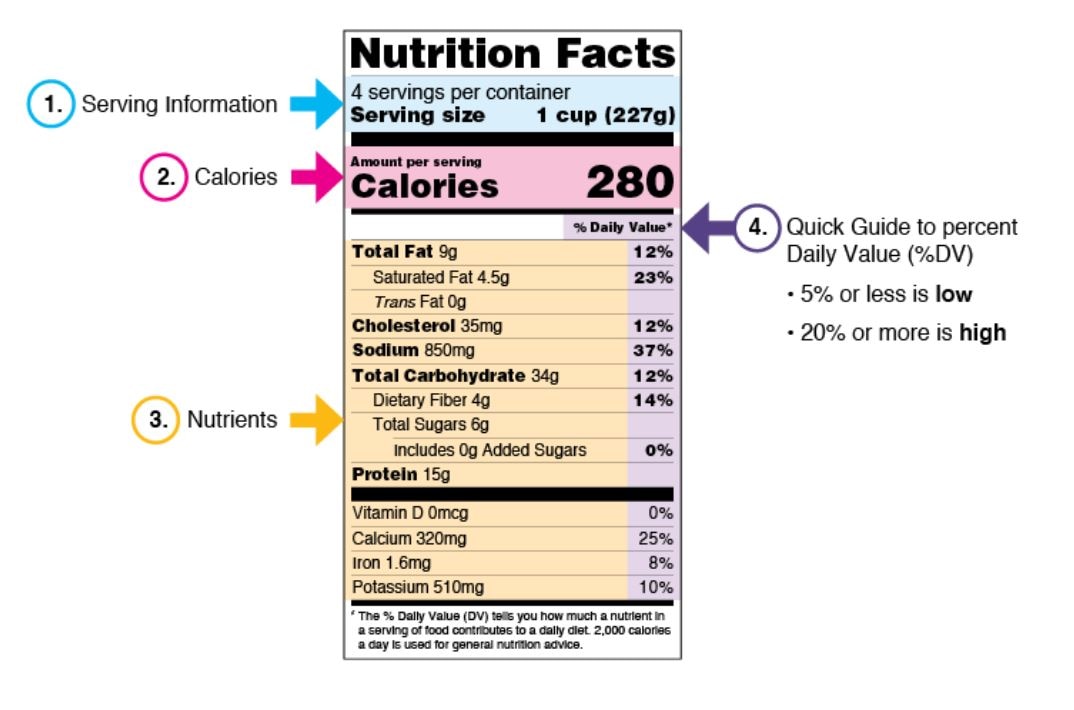 Sample Nutrition Facts label for frozen lasagnaSource: U.S. Food and Drug Administration
Sample Nutrition Facts label for frozen lasagnaSource: U.S. Food and Drug Administration
How can I eat 10 servings of vegetables a day?
Fill half your plate with fruits & veggies! Rather than fixating on consuming 10 servings of fruits and vegetables per day, we advocate that individuals seeking to improve their health and reduce their risk of chronic diseases focus on filling half their plate with fruits and veggies during each meal and snack.
How many pieces of fruit should you eat in a day?
For example, United States Department of Agriculture (USDA) guidelines recommend the average adult consume two servings of fruit per day, while the American Heart Association (AHA) recommends adults eat four to five servings of fruit per day.
What does 1 serving of fruit look like?
A half cup of dried fruit equals one cup of fresh fruit. One big piece of fruit is roughly a cup. An apple, an orange, a large banana, a nectarine, a grapefruit — one piece of fruit gives you one cup.
Is eating two apples a day too much?
Going above 70 grams is considered going overboard. Though for that one needs to eat 15 apples, it’s important to keep in mind the other sources of fibre in your daily diet. So, if you are having a healthy diet with more than two apples a day, it can lead to some serious digestive troubles.
What fruit has the most sugar in it?
Figs are the most sugar-dense fruit we found, with approximately 8 grams of sugar in just one medium-sized fig. A serving of figs usually amounts to four of the wrinkly fruits — meaning that you’d be consuming 32 grams of sugar total in your serving.
How many blueberries should you eat daily?
Summary: Eating a cup of blueberries a day reduces risk factors for cardiovascular disease — according to a new study. Eating 150g of blueberries daily reduces the risk of cardiovascular disease by up to 15 per cent.
What happens if I eat blueberries everyday?
According to a few studies, a bowl of blueberries can help in boosting immunity and can reduce the risk of diabetes, obesity and heart diseases. Moreover, consuming a small portion of berries daily can help in strengthening the metabolism and prevent any kind of metabolic syndrome and deficiency.
How much is a serving for each food group?
Advertising & Sponsorship
| Food group | 1,600-calorie diet | 2,000-calorie diet |
|---|---|---|
| Vegetables | 3-4 a day | 4-5 a day |
| Fruits | 4 a day | 4-5 a day |
| Low-fat or fat-free milk and milk products | 2-3 a day | 2-3 a day |
| Lean meats, poultry and fish | 3-4 one-ounce servings or fewer a day | 6 one-ounce servings or fewer a day |
What are the recommended portion sizes?
Have a healthy balance of foods each day:
- 1 1/2 – 2 1/2 cups of fruit and 2 1/2 – 3 1/2 cups of vegetables.
- 6-10 ounces of grain, 1/2 from whole grains.
- 3 cups of nonfat or low-fat dairy foods.
- 5-7 ounces of protein (meat, beans, and seafood) each day.
- No more than 5-8 teaspoons of oils, mostly from plants, fish, and nuts.
How do serving sizes work?
The serving size reflects the amount that people typically eat or drink. It is not a recommendation of how much you should eat or drink. It’s important to realize that all the nutrient amounts shown on the label, including the number of calories, refer to the size of the serving.
What is true serving size?
By law, serving sizes must be based on the amount of food people typically consume, rather than how much they should consume. Serving sizes have been updated to reflect the amount people typically eat and drink today.
What constitutes a serving size for each group in the food Guide Pyramid?
The Pyramid recommends eating 6 to 11 servings of grain products each day; several should be whole-grain servings. One serving is defined as 1 slice of bread, 1 small roll or muffin, 1/2 of a bagel or croissant, 1 ounce of ready-to-eat cereal, or 1/2 cup of cooked cereal, rice, or pasta.
Эмульгаторы, загустители, консерванты – что это и чем они опасны?
- Эмульгаторы – это группа веществ, помогающих сделать консистенцию продукта однородной. Чаще всего эмульгаторы используются в производстве напитков и десертов, а также в порошковых продуктах, чтобы облегчить их равномерное растворение в воде.
- Стабилизаторы и загустители — это специальные вещества, которые помогают придать продуктам нужную форму и сохранить её. Стабилизаторы добавляются при производстве колбасной и мясной продукции, в том числе потому, что они уничтожают опасные бактерии. И вместе с загустителями они используются при производстве кондитерских изделий, соусов и молочной продукции.
- Консерванты – это те вещества, которые помогают продуктам дольше оставаться свежими. Но это не всегда что-то опасное, например для рыбы консервантом является соль. Безусловно, среди этой группы можно встретить ряд более сложных веществ, влияющих на срок годности. Именно поэтому я не рекомендую злоупотреблять копчёностями и мясными полуфабрикатами, а фрукты предлагаю тщательно мыть перед употреблением, ведь их тоже обрабатывают специальными растворами, продлевающими свежесть.
Среди всех вышеперечисленных веществ есть как натуральные, так и синтетические, как безопасные, так и опасные представители. Поэтому старайтесь закупать еду у проверенных поставщиков и по максимуму уберите из рациона те продукты, составы которых насчитывают десятки ингредиентов. Ну и конечно, не стесняйтесь задавать вопросы экспертам
Зачем читать продуктовые этикетки
Чтобы быть здоровым. Еда — один из главных факторов, которые влияют на продолжительность и качество жизни. Прочитав этикетку, вы можете выбрать более здоровые продукты.
Например, о трансжирах не пишут на лицевой стороне упаковки, найти их можно только в составе. Эти вещества повышают риск инсультов и инфарктов, а ВОЗ призывает полностью запретить их производство. Если прочитать этикетку, то продукт с трансжирами просто не попадет к вам в корзину.
Другой пример: среднестатистический россиянин ежедневно съедает примерно 100 г сахара. Это в три раза больше безопасной для здоровья нормы. Сахар содержится не только в сладостях — его можно найти в кашах, крабовых палочках и соусах.
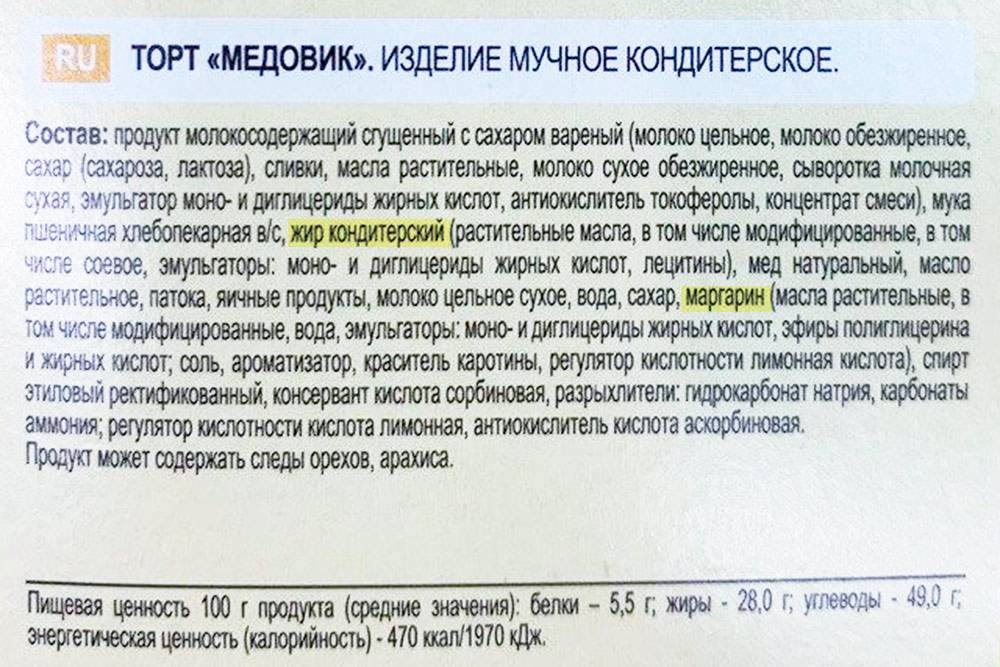


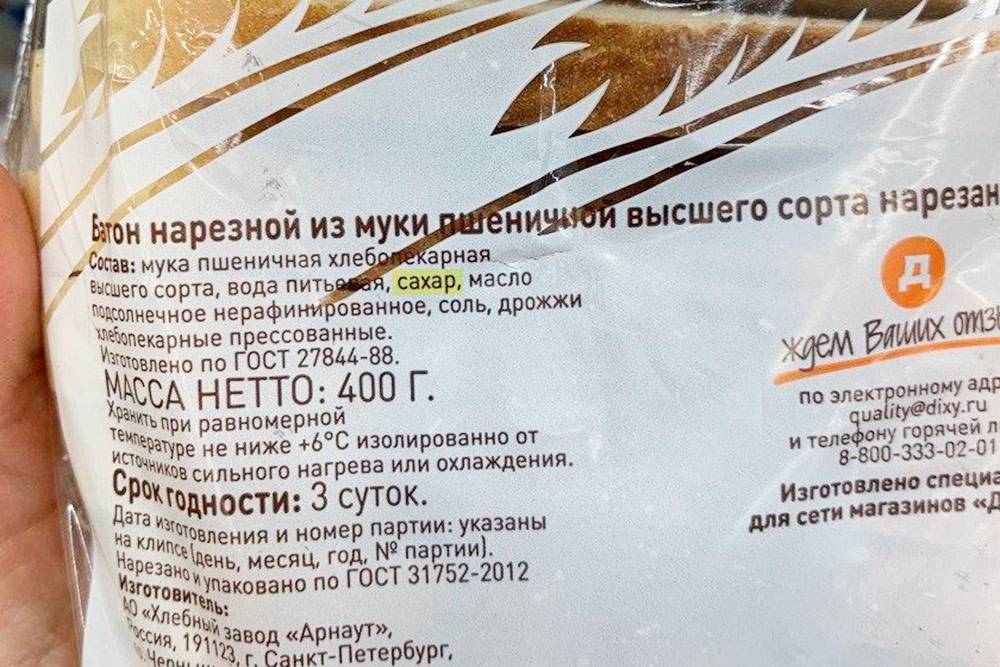


Чтобы сэкономить. Раскрученный продукт почти всегда стоит дороже невзрачного аналога, и только состав помогает понять, что внутри упаковки одно и то же. А еще чтение этикеток защищает от ненужных трат. Например, икра лососевая «царская» или «особая» может оказаться рыбным бульоном с загустителем. Производитель честно пишет об этом, но мелкими буквами и в самом неочевидном месте упаковки.
Чтение этикеток помогает устоять перед импульсивными покупками. Например, фраза «укрепляет иммунитет» на хлопьях может мотивировать купить, даже если рядом есть аналог в три раза дешевле. Если прочитать состав, то выяснится, что укреплять иммунитет тут нечем. Производитель накрутил цену за красивую надпись.
Две одинаковые банки фасоли, но одна в два раза дороже при пересчете на одинаковое количество граммовПо составу дешевый аналог ничем не хуже и даже полезнее, потому что не содержит сахар
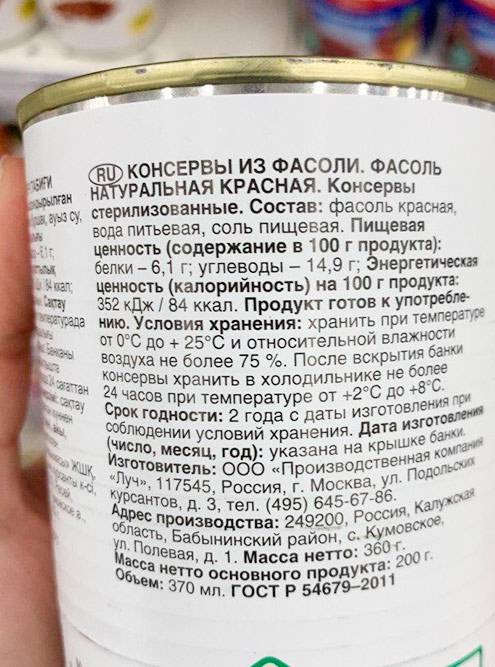
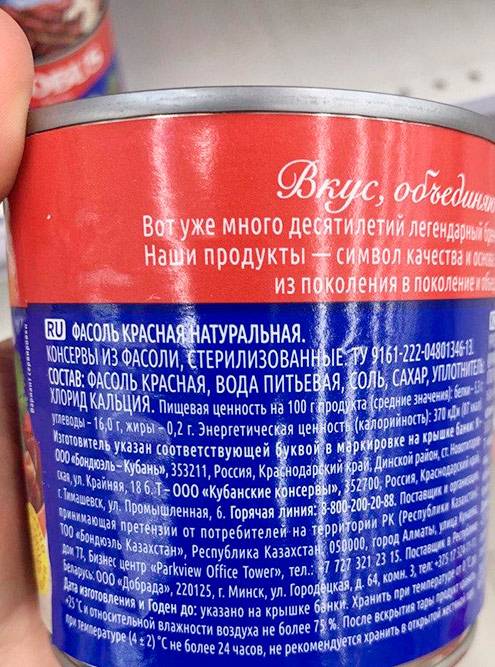
What does it mean 1 serving per container?
Servings Per Container shows the total number of servings in the entire food package or container. It is common for one package of food to contain more than one serving.
Table of Contents
How many servings are in a full container?
Servings per container shows how many recommended servings are in the entire package. If your child ate the entire package of macaroni and cheese, he or she would eat two servings (two cups).
How do you calculate servings per container?
To find this value, simply weigh the contents of your package (or count them, if in pieces) and divide by your RACC or serving size. If there are 980 grams of cereal in your package, for example, there are approximately 8.5 servings per container.
What does it mean if a package has 3 servings per container?
Dual-Column Labels For example, a bag of pretzels with 3 servings per container might have a label that looks like this to show you how many calories and other nutrients would be in one serving and in one package (3 servings).
How do you calculate servings?
Divide the Recipe into Servings. Once you know how much the entire finished dish weighs, divide the weight by the number of servings, which is usually listed in the recipe (“serves six,” or “serves eight,” for example). Round the result to an easy-to-remember number to find the average serving size.
What is the amount per serving?
Serving size is the first piece of information listed on the label. This is the amount of food that is typically eaten at one time. The size is in a basic household measurement, such as pieces, cups, or ounces. For example, a serving may be 7 potato chips or 1 cup of cereal.
Как работает добавка?
Из наиболее важных положительных эффектов серы можно выделить следующие:
Таким образом, добавка обладает не только противовоспалительным действием, но и антиоксидантым.
Противовоспалительный эффект
Исследование, проведенное у 100 человек в возрасте старше 50 лет, показало, что лечение добавкой, содержащей 1200 мг МСМ в течение 12 недель, уменьшало боль и отек в суставах по сравнению с плацебо. Группа, получающая добавку, также сообщила об улучшении общего качества жизни и ходьбы.
В другом исследовании, проведенном у 32 человек с болями в пояснице было обнаружено, что прием добавок глюкозамина, содержащих МСМ, значительно уменьшает боль в пояснице при движении, а также значительно увеличивает качество жизни. Противовоспалительные свойства МСМ хорошо документированы научными исследованиями.
Считается, что МСМ уменьшает продукцию цитокинов, таких как фактор некроза опухоли альфа (TNF-ɑ) и интерлейкин 6 (IL-6), которые являются сигнальными белками, связанными с системным воспалением.
Кроме того, МСМ может увеличить уровень глутатиона, мощного антиоксиданта, вырабатываемого вашим организмом.
МСМ может уменьшить выделение молекул, связанных с воспалением, таких как TNF-ɑ и IL-6, а также повысить уровни мощного антиоксидантного глутатиона.
Восстановление мышц
МСМ может ускорить восстановление после тренировки, уменьшив повреждение мышц и стресс. Во время нагрузок происходит повреждение мышц и увеличивается выделение молочной кислоты. Это заставляет спортсменов ощущать боль в мышцах, что может препятствовать тренировкам и восстанолние.
MSM может естественным образом ускорить восстановление мышц после интенсивных нагрузок за счет уменьшения воспаления и снижения молочной кислоты.
В одном из исследований 22 здоровые женщины получали 3 грамма МСМ или плацебо в день в течение трех недель. Группа, получающая МСМ, сообщила об уменьшении мышечной боли и боли в суставах, в отличие от групп, принимающих с плацебо.
МСМ может помочь уменьшить боль, повреждение мышц, помогая быстрее восстанавливаться.
Помогает облегчить симптомы артрита, уменьшая боль
Артрит является распространенным воспалительным заболеванием, которое вызывает боль и уменьшает диапазон движения в суставах. Поскольку МСМ обладает мощными противовоспалительными свойствами, его часто используют в качестве естественной альтернативы лекарствам для улучшения симптомов, связанных с артритом. Кроме того, он может повысить эффективность других обычных добавок, используемых для лечения артрита, таких как глюкозамина сульфат, хондроитинсульфат и босвеллиевая кислота.
Одно исследование показало, что сочетание МСМ с глюкозамином и хондроитином было более эффективным при уменьшении боли у людей с остеоартритом коленного сустава, чем отдельные добавки глюкозамина и хондроитина.
Другое исследование показало, что ежедневная добавка, содержащая 5 г МСМ и 7 г босвеллиевой кислоты, была более эффективной, чем глюкозамин, при уменьшении боли и улучшении функции у людей с остеоартритом коленного сустава.
eCPM marketing and advertising
As we mentioned, eCPM is also critical for measuring and optimizing the performance of user acquisition campaigns — the higher the campaign’s eCPM, the more impressions it’ll win and the faster it’ll scale.
Take a look at the graph below and remember that eCPM for user acquisition managers equals CPI multiplied by IPM. That means Campaign A has an eCPM of $5, Campaign B $10, and Campaign C is upwards of $40.
Campaign A’s eCPM is too low to win a high share of voice on the network, while Campaign B’s eCPM is good enough to win a majority of a network’s impressions. Campaign C, meanwhile, has such a high eCPM that UA managers can actually increase their margins, or lower their CPI, and still see the same campaign performance. That’s usually due to an incredibly high IPM, from a high-performing creative.
What is the 80/20 diet?
The 80/20 rule is a guide for your everyday diet—eat nutritious foods 80 percent of the time and have a serving of your favorite treat with the other 20 percent. For the “80 percent” part of the plan, focus on drinking lots of water and eating nutritious foods that include: Whole grains.
Do you have to eat healthy if you exercise?
The Truth: You can easily out-eat your exercising. It’s essential to both work out and eat right for successful weight loss and to maintain good health.
What is the 10 5 10 eating rule? 10–5–10 rule: Eat for 10 minutes, take a break for 5 minutes — a complete halt on eating, and resume for another 10 minutes. By the end of these 25 minutes, there are high chances that you would have eaten less than you normally would have, and still feel “full”.
What are the 3 macronutrients? Carbohydrates, fat and protein are called macronutrients. They are the nutrients you use in the largest amounts.
More from Foodly tips!
Which is better? 100g/ml or Serving size?
With respect to India, nutrient declaration as per 100g/ml of the food product is a more established, standard and widely followed practice of declaration. Serving Size on the other hand, is a newer concept with only a few manufacturers adopting it. The U.S FDA has defined serving size as the amount that people typically eat or drink in one sitting.
If the values of nutrients are denoted as per their serving size, then these values will be different in different products and will therefore lack the ability to be compared with similar products in a category, unlike that of products declared as per 100g/ml.
In the case of nutrient profiling, which is done to classify or rank the product on the basis of its nutrients, nutrient declaration per serving size is preferred. The reason is that calculations done for 100g of a product may give out wrong results and impressions. For example, energy-rich foods consumed in lesser quantities like nuts will get a high energy score, while products like sugar-sweetened beverages usually consumed in quantities above 100ml, will get a favourable score. Hence although nuts are much healthier, sweetened beverages score better in terms of energy.
From the consumer’s perspective, indicating nutrient information per serve is much more recognizable because consumers can better relate these values with respect to their portions. However, there have been tremendous concerns about the variability in serving sizes declared on the pack among products of different and same categories. Since serving size is set by manufacturers themselves, certain of them indicate large serving sizes to increase the nutritional values of their product. This misleading information fools the consumer who thinks that the product is nutrient-rich.
One disadvantage of declaring nutrition information per 100g/ml is that in the case of lightweight products like powders, nutrient information per 100g will mislead the consumer as he/she may think that consuming one serving of the product will provide the nutrients as declared for 100g.
Аналоги
Если БАДа от Now Food нет в наличии, стоит обратить внимание на аналоги:
Now Foods, Жидкий витамин D3, 1 000 МЕ (30 мл)
Now Foods, Жидкий витамин D3, усиленный, 1 000 МЕ, 1 жидкая унция (30 мл)
Капли изготовлены на основе кокосового масла. В одной капле содержится 1000 ед. витамина Д3. Плюс капель в том, что можно регулировать ежедневную дозу.
Solgar, Витамин D3 (холекальциферол), 5000 МЕ, 240 капс.
Solgar, Витамин D3, холекальциферол, 5000 МЕ, 100 мягких желатиновых капсул
Препарат полностью аналогичен Now Food, но стоит в два раза дороже. Количество капсул и дозировка такая же. Стоит покупать поклонникам компании Solgar.
























